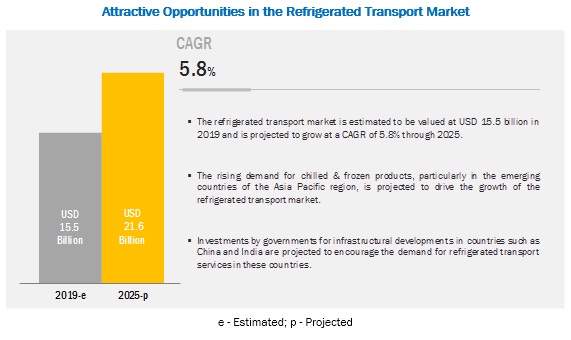According to MarketsandMarkets, the refrigerated transport market is estimated to be valued at USD 15.5 billion in 2019 and is projected to reach USD 21.6 billion by 2025, recording a CAGR of 5.8% from 2019 to 2025. The growing demand for frozen food due to the increasing urbanization and changing lifestyle are factors projected to drive the market for refrigerated transport.
Refrigerated transport services are gaining importance in the food industry due to the increasing demand for processed foods at a global level. The frozen and chilled food segments are projected to be the key revenue pockets for the refrigerated transport market in the near future. Developing countries such as India and Brazil are projected to create lucrative opportunities for frozen and chilled food manufacturers and service providers of refrigerated transport in the coming years.
Download PDF Brochure@
https://www.marketsandmarkets.com/pdfdownloadNew.asp?id=779494
Service providers are looking for new strategies to select transport modes with a view to cutting costs and increasing supply chain efficiency. Currently, intermodal transport is increasingly used in the food & beverage industry. Intermodal transport relies primarily on rail shipments and transports perishable commodities using multiple modes of transportation (trucks, ship, and air). Reefer containers are also utilized in intermodal transport. Service providers take advantage of the attributes of both trucks and rail shipping. Refrigerated railroad cars save considerable fuel and carry high volumes of perishable commodities than cargos over long distances. Refrigerated trucks, vans, and trailers transport delivers between rail terminals and the final delivery point. Intermodal rail shipments can reduce highway congestion and emissions. Their ability to control costs is a primary driver, which will benefit service providers and end users. A single rail shipment also conserves approximately 100,000 gallons of diesel fuel, and according to EPA estimates, it reduces CO2 emissions by 85,000 metric tons a year.

Refrigerated Transport Market
Therefore, service providers are considering the adoption of this mode of transport for cost reduction, improvement in efficiency, and reduction of environmental impact.
Multi-temperature trucks store different products at different temperatures using multiple-refrigeration systems. These trucks and trailers are segmented into flexibly sized compartments using curtain-like structures called skinny buns. Multi-temperature compartments are similar to single-temperature compartments and use control and monitoring systems that assess the temperature of the refrigerated environment at regular intervals. Retailers using single temperature trailers have to list multiple trucks to deliver shipments. However, multi-temperature trucks combine these shipments in one load. They increase the capacity by up to 60%, depending on the design and materials used. The use of multi-temperature refrigerated trucks reduces emissions and is economical. These trucks witness significant demand, particularly in developed countries.
Speak to our analyst for a discussion on the above findings@
https://www.marketsandmarkets.com/speaktoanalystNew.asp?id=779494
The Asia Pacific refrigerated transport market is projected to witness a higher growth potential in the coming years. Frozen and chilled food products provide the option of convenience, along with maintaining nutrition and are increasingly preferred among consumers in the emerging economies of Asia Pacific, due to the rapid urbanization and increased spending capacities. For instance, in 2019, a survey conducted by ASSOCHAM (The Associated Chambers of Commerce and Industry of India) stated that the packaged food market in India is expected to reach USD 72.6 billion by 2020 from USD 31.7 billion in 2015. This growth is attributed to a surge in the consumption of frozen foods, dairy products, ready-to-cook/ready-to-eat foods, and bakery products, which in turn, creates the demand for refrigerated transport for convenient and efficient transportation of such products.